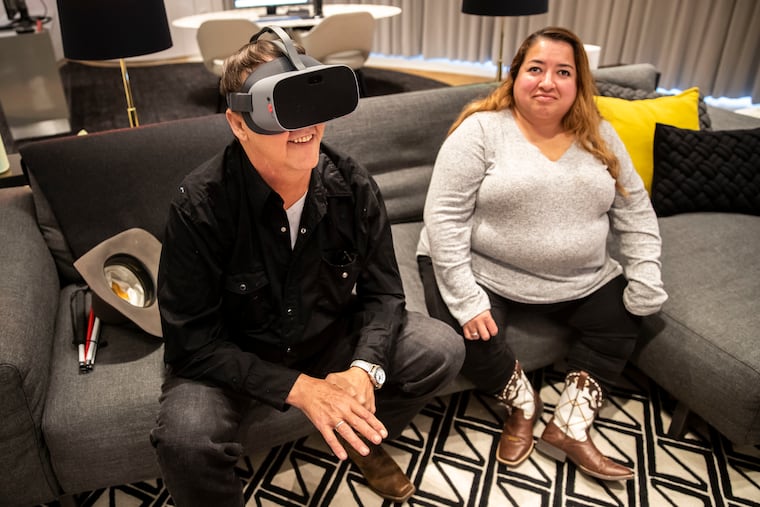Americans with disabilities have $200 billion in spending power. Comcast isn’t leaving them behind.
This year, Comcast has announced a series of partnerships for new programs, products, and services for people with disabilities.

James Baldwin thought he’d never see his granddaughter’s face again.
The 18-year Army veteran started to lose his vision three years ago from an injury he suffered in the Gulf War. He lost his left eye and was left with limited vision in his right, reducing his sight to light and shadows. He can see shapes but not faces.
That was until October, when Baldwin put on a pair of NuEyes electronic glasses, which enhance the vision of visually impaired people. Suddenly, he could clearly see his wife sitting beside him. Leaves on trees. A picture of his granddaughter in her basketball uniform.
“She loves basketball, she loves softball, and being able to see her like that, it meant a lot‚” Baldwin, 58, of Alexandria, Va., said last week. “I can be standing right next to her and wouldn’t really see her, but being able to see her face, what a beautiful young lady she’s turned into, it was amazing.”
Baldwin received the “early Christmas present” from Comcast and NuEyes, a wearable technology start-up. NuEyes customers can now watch live TV and on-demand content through the smart glasses and virtual reality headset with the Xfinity Stream app, Comcast said this month.
The partnership was the latest announcement from Comcast this year about new programs, products, and services for people with disabilities. Earlier this month, Comcast said it was the first in the cable industry to offer customer service in American Sign Language. In June, the company unveiled a web-based remote allowing people with physical disabilities to control their televisions with their eyes. And in August, Comcast expanded its low-cost broadband program to low-income households that have people with disabilities.
Comcast is among major companies using new technology to design products that are more inclusive. Microsoft, for example, sells an adaptive Xbox video game controller with large buttons for gamers with limited mobility. For blind consumers, Apple’s devices include screen reading technology that reads web content aloud. Products that aren’t tailored for people with disabilities, such as Amazon’s Alexa voice assistant, have helped too, experts said.
“Accessibility is not a feature. Accessibility really is the measure of how effective or how inclusive your product is,” said Tom Wlodkowski, Comcast’s vice president for accessibility. “The idea was, let’s build products that work for everyone. And let’s open up our products to the widest possible audience inclusive of people with disabilities.”
Wlodkowski, who is blind, noted that a third of U.S. households have a member with a disability, according to a 2016 Nielsen survey. “The disability community represents $200 billion in discretionary spending power,” he said. “So it makes sense to do this.”
He joined Comcast in 2012 and oversees a dozen people focused on accessibility while working with the company’s product teams. Comcast has developed features in recent years such as “voice guidance,” which helps low-vision consumers navigate the TV by reading what’s on screen aloud, and “video description,” which is extra narration during pauses in dialogue in a movie or show.
Comcast now has four customer-service employees trained to communicate to deaf customers in American Sign Language. The program is in a pilot phase, but the company said it will evaluate and adapt in the future. It is expected to reduce average call times by up to 40%. Comcast announced the program in December at the Pennsylvania School for the Deaf, where it gave 90 students free tablets and six months of internet service.
Comcast’s eye-control remote was recently named one of 100 “Best Inventions" of 2019 by Time magazine. Customers can change channels and record and search for shows on a tablet or computer screen using eye-tracking technology. Comcast said it isn’t measuring how many customers are using the remote right now.
For customers such as Jimmy Curran, 30, a Philly resident with spinal muscular atrophy, the eye control remote means he no longer needs others to operate the TV. Before, he was sometimes stuck on the same channel for a long time, missing out on college football games he wanted to watch.
“Saturdays are typically times when I spend time alone without an aide or company," he said. “So it’s enabled me to have the ability to change the channel.”
While Comcast’s eye remote is available for free online, consumers still need compatible equipment that can cost hundreds or even thousands of dollars. Smartglasses such as NuEyes can cost thousands of dollars, too. And many people with significant disabilities are on limited incomes, experts said.
“I think anything that enables people to manage their own environment on their own terms is worthwhile,” said Dyann Roth, the CEO of Inglis, the largest private provider of affordable accessible housing in the Philadelphia region. “The challenge, I think, and not from the technical standpoint ... is it has to be affordable.”
There are still some gaps in the technology. Comcast’s voice remote, for example, helps people with disabilities by letting them change channels without pushing several buttons or seeing what’s on screen. But it still requires consumers to press one button before speaking, limiting those with physical disabilities.
“In general, I think there is definitely a large need for some type of hands-free remote system for people to be able to control their TVs, which has been an ongoing need for a long time," said Jessica Doran, therapy supervisor in the spinal cord injury program at Magee Rehabilitation Hospital in Philadelphia.